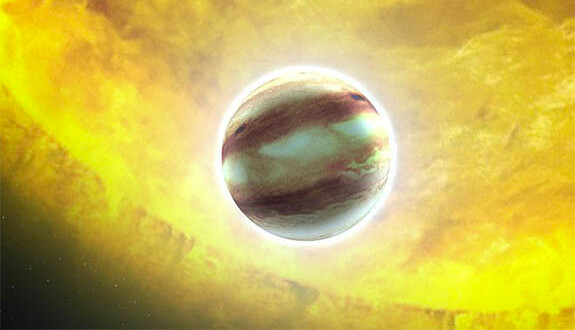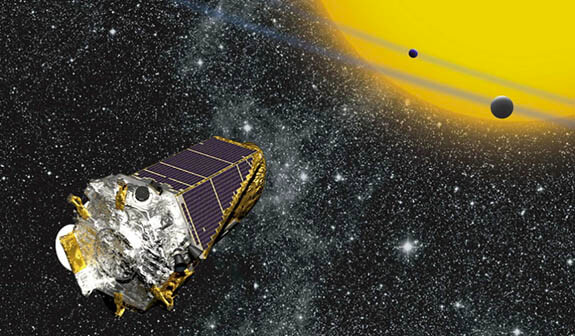Scientists noticed shimmering clouds.
Astronomers at the University of Warwick in the UK have identified a massive exoplanet with cloud formations densely packed with rubies and sapphires.

Photo via NASA.gov
Located 1,000 light years away, the blistering hot Jupiter-like planet — named HAT-P-7b — was studied using NASA’s Kepler space telescope. Researchers monitored HAT-P-7b for four years and witnessed unusual shimmering cloud systems being propelled by a powerful jet stream.

Photo via NASA.gov
Advertisement
“When we say clouds, they’re definitely not like clouds on earth,” noted lead researcher David Armstrong in the science journal Nature.
The clouds were shimmering, the scientists suggested, because they were infused with a crystalline form of aluminium oxide — also known as the mineral corundum. Rubies and sapphires are the gem variety of corundum. HAT-P-7b gets so hot that minerals vaporize in the atmosphere.
The HAT-P-7b exoplanet is 16 times larger than the Earth and much closer to its host star — making temperatures an inhospitable 4,532 degrees Fahrenheit.
The exoplanet can achieve a full orbit of its star in a mere 2.2 days, a trip that takes the Earth 365 days to complete.
The Kepler space observatory was launched by NASA in 2009 with the goal of discovering Earth-size planets orbiting other stars. It’s currently 100 million miles from Earth.
While UK scientists believe exoplanet HAT-P-7b is teeming with sapphires and rubies, U.S. researchers previously floated the idea that it’s raining diamonds on Jupiter.
Advertisement
In 2013, two prominent scientists — Dr. Kevin Baines of NASA’s Jet Propulsion Laboratory and Mona Delitsky from California Specialty Engineering — outlined the circumstances under which Jupiter’s atmosphere would rain down thousands of tons of diamonds every year.
While diamonds on the Earth come from the bottom up, diamonds on Jupiter come from the top down, said the scientists.
Baines and Delitsky believe the tremendous gravitational pull of Jupiter results in a super-dense atmosphere of extreme heat and pressure — the same conditions found deep within the Earth.
Lightning storms in the upper atmosphere of Jupiter are responsible for initiating the process that eventually yields a diamond. When lightning strikes, methane gas is turned into soot, or carbon.
“As the soot falls, the pressure on it increases,” said Baines. “And after about 1,000 miles it turns to graphite — the sheet-like form of carbon you find in pencils.”
As it falls farther — 4,000 miles or so — the pressure is so intense that the graphite toughens into diamond, strong and unreactive, he said.
Advertisement
The biggest diamond crystals falling through the atmosphere of Jupiter would likely be about a centimeter in diameter — “big enough to put on a ring, although, of course, they would be uncut,” Baines said.
HOWARD COHEN is the Shoreham, NY-based editor of The Jeweler Blog, a daily blog ghost-written for retail jewelers. Cohen, a long-time industry veteran, is dedicated to making social media tasks simple and affordable for every jeweler. For more information, visit thejewelerblog.com or contact Cohen at 631-821- 8867, hscohen60@gmail.com. Websites: thejewelerblog.com,thejewelerblog.wordpress.com.
This article is an online extra for INSTORE Online.